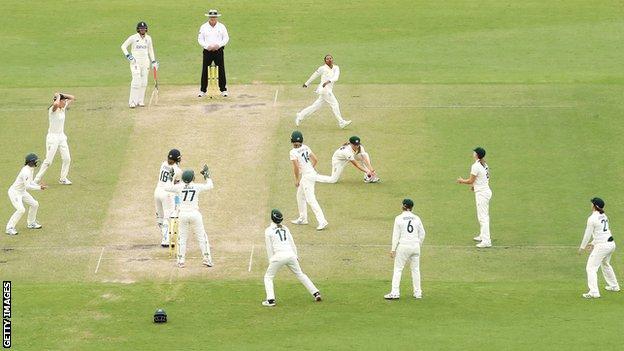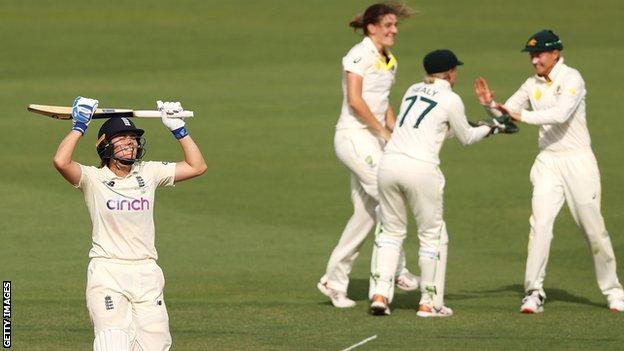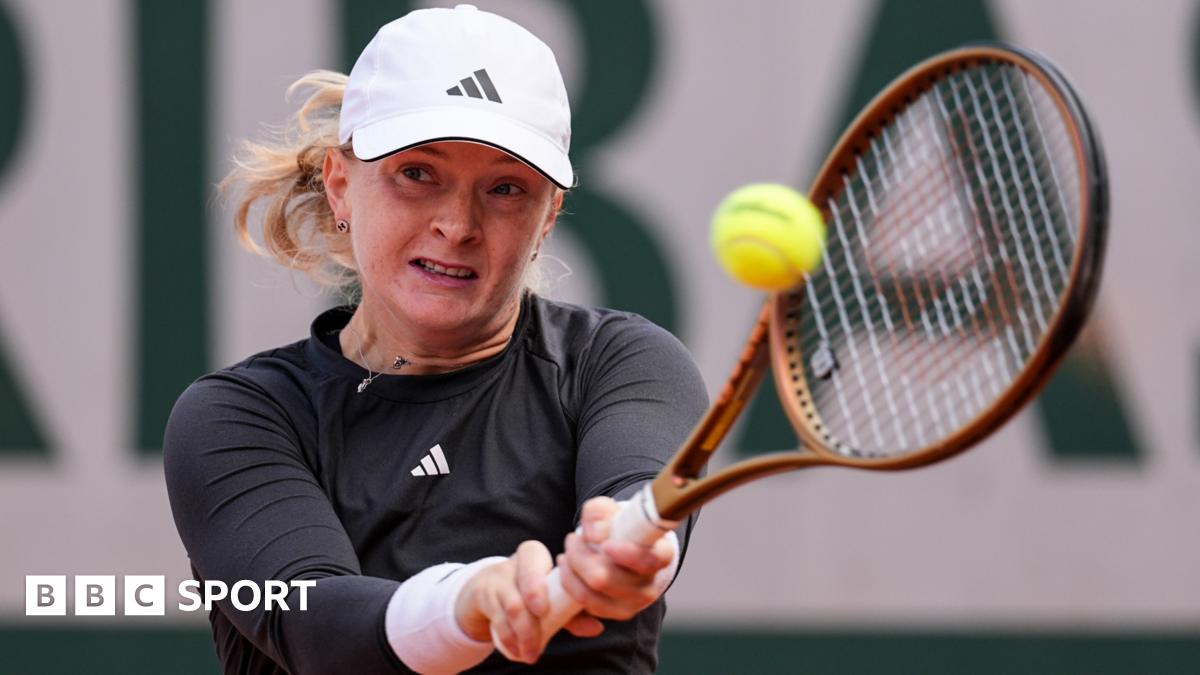ARTICLE AD BOX
 Kate Cross blocked out the final ball of the Women's Ashes Test to ensure it finished as a draw
Kate Cross blocked out the final ball of the Women's Ashes Test to ensure it finished as a drawThis is how the game should be.
Nine women crowded around the bat, plus the wicketkeeper close behind the stumps, plus the bowler guarding the non-striker's end. A field packed like a morning Tube station. The last batting pair at the crease, too nervous to do so much as meet in the middle. A couple of deliveries separating all four results: Australia win, England win, tie, draw.
For a couple of hours, England had a chance to pull off the biggest and boldest run chase in women's Test cricket history. When those hours were done, and the match was drawn, the cold, hard statistics could tell you it was one of the closest finishes the game has produced. The far less quantifiable things - the feeling, the tension, the atmosphere - at the ground, told you that it was one of the best.
Of course, there were things that could have been different. Australia had to set up that finish with a declaration challenge, betting that England could not chase 257 runs in 48 overs. England had to take up that challenge, albeit with little left to lose in a multi-format Ashes series they trailed on points.
If administrators allocated these matches five days instead of four, things would have been different. If rain had not wiped out most of the third day, different again. If Australia had batted more boldly in the third innings, they might have set a bigger target with more time to spare.
But what was done was done. In this instance, at this moment, both teams had only what was in front of them. A score to target or a score to defend, with the hope that the final innings would either stay together or fall apart. In this instance, that contest turned into something glorious.
As England began, they displayed a concerted effort to attack instead of letting the match wander towards a draw. Tammy Beaumont started it off. So often England's aggressor in the shorter formats, here she took it into the dying hours of the longest form. Off the pads, on the cut, she picked off boundaries as she dominated a 52-run opening stand.
Her partner Lauren Winfield-Hill then took up the cudgels and when she was out with the score on 92, the stage was set for Heather Knight and Nat Sciver.
They reduced the required total to double figures and the Australians began to panic. The field changed by the delivery, boundary riders scattering then being recalled. Bowling changes were being made by the over. What had been Australia's game for three-and-a-half days now looked like England's.
As the fourth day faded, the sun broke through beneath clouds that had previously smothered this Test. The humidity seemed to rise in tandem with the tension, the air growing sticky around everybody invested in every ball. The middle of the ground must have felt like a slow-cooker, gradually heating meat off the bone.
Knight fell just before a half-century, Sciver fell just after one. England's composure looked to be lost. But the tension kept climbing, the crowd cheering wide leg-side deliveries purely for not conceding a run.
 Heather Knight fell for 48 on a dramatic final day
Heather Knight fell for 48 on a dramatic final dayFor two teams that so rarely get the chance to play Test cricket, the chance to win or lose one was something exciting but also foreign.
Perhaps that is why the less experienced players found ways to stamp their influence on a game so delicately balanced. Nobody had told Sophia Dunkley that Test players don't smack two sixes in a row deep in a chase as they hit 45 runs in 32 balls. Annabel Sutherland and Alana King have little scar tissue from past disappointments so were not afraid to bowl.
It was not all calmness and control though. When Sciver fell, it was England's turn to look unsettled. Amy Jones tried to match Dunkley's hitting when she only needed to nudge a single, and instead left her partner with the tail.
No messages were taken out to encourage those in the middle to take a deep breath and calm their approach. The only cool was shown by Australia's Beth Mooney, broken jaw forgotten, as she took one of the bravest catches the game has seen when Dunkley tried to keep going.
Amid the final flurry, the game could have gone in any direction. A few sweet blows from England's lower order, a lucky inside edge or a flying nick could have changed things. But Australia's captain Meg Lanning stationed a fielder to save the outside edge, and the wickets kept falling until it was England who were suddenly struggling to hold on.
As the last ball of the match came down, a full toss from debutant leg-spinner King, England's number 11 Kate Cross must have dreamed of putting it over the rope. But that would still have left England six runs short of the win, so she did the team thing and patted it into the ground.
Both sides had a taste of victory, but both had also smelled the fear of losing.
In the end, perhaps the right result was reached. Australia did not have to set England a target, but did. England did not have to go after it, but did.
The constraints under which women's Test matches are played meant the finish had to be engineered.
But for those who watched it, soaked in anxiety and elation right down to that final ball, the context for a while did not matter. The contest was all that did.

- Transfer Gossip Daily: What are the biggest rumours as deadline day approaches?
- Want to book holiday this year? Here are some do's and don'ts of booking your trip abroad


 3 years ago
43
3 years ago
43








 English (US) ·
English (US) ·